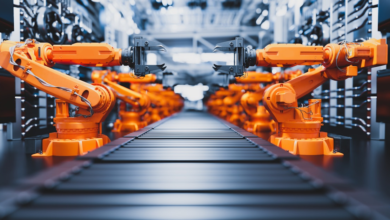Robots that look like us: “What’s happening now is incredibly exciting”

We’ve seen
prototypes of human-like robots for years now: Robots that can talk, walk, and
lift things.
It’s fascinating,
but these projects are still at the pilot stage and are used to demonstrate the
technology, not market it.
But now, a number
of companies are working to create human-like robots to sell.
The Norwegian
company 1X has already commercialised a robot called EVE, which is currently working in security.
“We’re close to a ChatGPT moment for robotics,” says Bernt Øivind Børnich.
He is the CEO
of 1X.
One robot, many tasks
A great deal of
factory and production work has already been automated. One of the arguments
for creating humanoid robots is that they can, in theory, do many of the same
things as humans.
Instead of building
many different specialised robots, it’s possible to build a humanoid robot that
can learn how to perform many different tasks in an environment designed for humans.
It is clear that
humanoid robots are trending, says Kai Olav Ellefsen. He is an associate
professor at the University of Oslo and participates in the research group for robotics and intelligent systems.
“I think many have realised that the technology needed to create a humanoid robot is
starting to fall into place. It may be close to beginning a useful product,” he
says.
It’s reminiscent of
when smartphones first arrived on the market.
“Many of the components
of this technology were ready to go, such as touchscreens, batteries, and other
components. When Apple managed to create one, many others could follow suit. It
may be that we’re somewhat in the same place now with humanoid robots,” says Ellefsen.
Collaboration with OpenAI
Investors have
poured a lot of money into promising companies.
Figure, founded in 2022, already has an advanced robot to showcase. The goal is
to build a robot that, with the help of artificial intelligence, can take over jobs
that are unsafe for humans, or that humans don’t want to do.
In February,
investors like Jeff Bezos, Nvidia, and Microsoft invested 675 million USD in the
company. Figure has also entered into a collaboration with OpenAI, which is the
company behind ChatGPT.
Norwegian company 1X has
also teamed up with OpenAI.
The start of a new era
Figure’s
collaboration with OpenAI appears to be fruitful. A new video released in
March has impressed experts interviewed by sciencenorway.no.
In the video demonstration,
the robot Figure 01 performs tasks based on verbal commands and explains its
choices.
The way the robot talks and moves in the short demonstration appears startlingly human-like.
“The link between robotics and
artificial intelligence is obvious, but not that easy. It is hugely
impressive what they have achieved,” says Morten Goodwin.
He is a professor at the
University of Agder and an expert in artificial intelligence.
“I’m confident that this is the beginning of a new era where robots become much smarter than we are used to,” he says.
Expects a growing market
Goldman Sachs
estimates that the global market for humanoid robots could reach 38 billion USD by 2035.
This is an upward
revision from their previous estimate of 6 billion USD in 2022.
The company wrote
that the main reason behind their revised assessment is advances in artificial
intelligence with large language models. There are also indications that components
will cost less than expected.
In their scenario,
more than 250,000 humanoid robots will be delivered in 2030, most for industrial use. Goldman Sachs expects annual deliveries to increase to one
million robots in about a decade.
Elon Musk is on it
Figure and 1X are
not the only ones with big ambitions.
Tesla is working on its humanoid robot called Optimus. This robot is intended to take over unsafe, repetitive, or boring tasks.
Elon Musk believes
it will become the company’s most valuable asset.
“As I’ve said
before, I think Optimus will be more valuable than everything else combined,”
Musk said recently, according to
Business Insider.
Musk believes Optimus will perform useful tasks by the end of this year and that the robot could be available for purchase by the end of next year. He adds that this is just speculation.
Watch Optimus fold
a t-shirt in the video below.
Doesn’t have to look human
Agility Robotics
has created a robot called Digit. It resembles a human but has legs like a
grasshopper. The robot is designed to work in a warehouse or in production alongside humans.
Digit is being
tested in warehouses in collaboration with Amazon.
“What’s happening
now is incredibly exciting,” says Evi Zouganeli.
She is a professor at OsloMet, Oslo Metropolitan
University. She studies the intersection between artificial intelligence and
robotics.
“The development of
human-centric robots is thrilling and truly impressive. Things are happening quickly now. We are seeing a development where several more important building blocks
are gradually falling into place,” she says.
Zouganeli prefers
the term human-centric robots rather than humanoid robots.
“Even though they often have two legs and two arms and are somewhat human-like, that is not the
goal. The goal is for them to function in our surroundings, interact with us, and aim to assist us. Eventually, they will
hopefully be able to perform heavy, tedious, and dangerous tasks,” she says.
“It’s not certain
that people like robots that look like humans. Maybe robots should look like
robots but behave like well-mannered, reliable, and kind humans.”
Several companies
are competing in this field, says Zouganeli. Some seem to excel in mobility
and stability, others in strength, precise manipulation and dexterity, and others in communication and thinking, according to the researcher.
May seem smarter than they are
At the same time,
Zouganeli points out that the robots shown in demonstrations can appear more
intelligent than they are. We might see a robot that talks, understands what is being said, and performs a task, as in the video of Figure 01.
“But here, the
context is defined, and the environment is relatively simple – a table with
objects, a person asking questions, and asking the robot to do something. Not
much else happens,” she says.
Zouganeli adds that the robot would
hardly perform as well in an uncontrolled and unstructured environment where the
context is unknown and complex.
“Robots still don’t have a comprehensive understanding of everyday situations; they don’t grasp what is going on, the
intentions of the people around them, intended and unintended consequences, and
so on,” she says.
If robots are
really going to be useful, they should be able to perform complex tasks and
function reliably in an unstructured environment, such as on a street or
in a private home, says Zouganeli.
“In these
situations, they have to be able to perceive context, have a sufficiently
nuanced perception of human and material values, a certain understanding of
risk, and be able to foresee consequences,” she says. “We’re not there
yet, but progress is being made.”
Most are initially aiming to create robots for environments that are characterised by routine.
Where are all the self-driving cars?
In theory, smart and autonomous
humanoid robots could provide labour where there are shortages, help
the elderly with household tasks, or function as an assistant.
Not everyone agrees
that the technology is ready yet.
“Many have recently
invested in companies that work with human-like robots. But there are still
some who are sceptical and believe that we are too far off,” says Ellefsen.
Apple is instead
investing in a small, wheel-based device that can follow you around at home, he adds.
“What makes me most
sceptical is that we saw the same hype for self-driving cars ten years ago,” says Ellefsen.
“We’ve long believed that self-driving cars were close to being robust enough for
all kinds of situations, but we haven’t gotten there yet. Training a
self-driving car is very similar to training a home robot.”
To be tested by car manufacturers
If robots can’t
drive cars, maybe they can help make them.
The company Apptronik
has entered into an agreement with Mercedes-Benz. The car manufacturer will
test the robot Apollo.
Apollo will, among other tasks, deliver parts to people working on the production line, according
to The Verge.
Another player is
Boston Dynamics. Over the years, they have impressed people with their
extremely athletic robots.
A new version of
the Atlas robot will be tested at Hyundai, Boston Dynamics
announced in April.
Watch the company’s
previous version of Atlas perform parkour in the video below.
China is also
betting on this technology. The country’s Ministry of Industry and Information
Technology aims to mass-produce humanoid robots by 2025, according to the South China Morning
Post.
See more active humanoid
robots in a list from Built In.
Thinks the robots are coming
Experts that sciencenorway.no
has spoken to believe that human-like robots will be performing jobs in society within a few years.
In a podcast from
the beginning of 2023, Morten Goodwin predicted that assistant robots would
arrive within five years, by 2028.
Assistant robots function autonomously, meaning they control themselves and can perform simple
tasks upon receiving instructions from humans.
“This doesn’t mean these robots will be everywhere, but it will be a product available for purchase. It will take several years before they become commonplace,” says Goodwin.
Gradual development
Kai Olav Ellefsen
also believes that humanoid robots will be put to work within a few years.
Part of the reason
for this, according to Ellefsen, is that many companies are adopting a strategy of gradual implementation. Robots will initially work in environments where they are most likely to succeed.
This involves structured and
standardised tasks, such as in warehouses or factories.
“From there, they will move into more complex environments, like hospitals, and eventually into homes, where many unforeseen events can occur and mistakes can have significant consequences,” he says.
The speed of development will depend on how widely the first robots are adopted, Zouganeli suggests.
“These robots are
going to cost a lot to begin with. It’s a chicken-and-egg situation. The more they are used, the cheaper they will become, allowing for the development of more
advanced versions for more challenging tasks in complex
environments,” she says.
“We are likely to see human-centric robots in packaging, sorting, storage, distribution, light
industry, and production soon,” she predicts.
Gradually, there
will likely be more applications with specialised tasks, such as office or hospital staff, Zouganeli believes.
“In the long term, we may also see robot assistants as a
shared resource in nursing homes and care facilities,” she says.
———
Translated by Nancy Bazilchuk
Read the Norwegian version of this article on forskning.no



